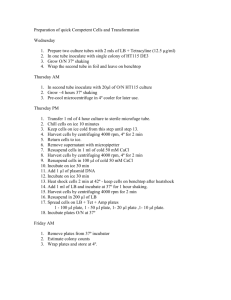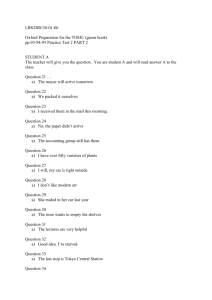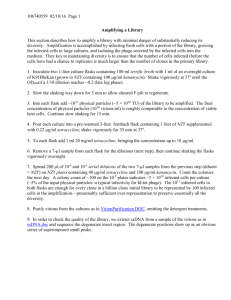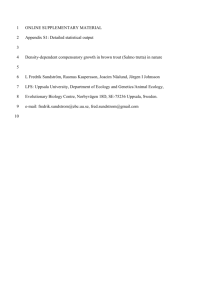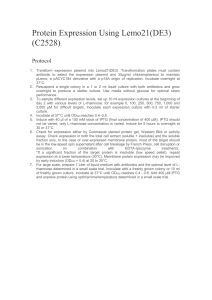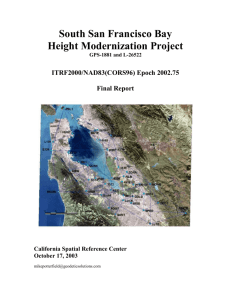TUtiter
advertisement
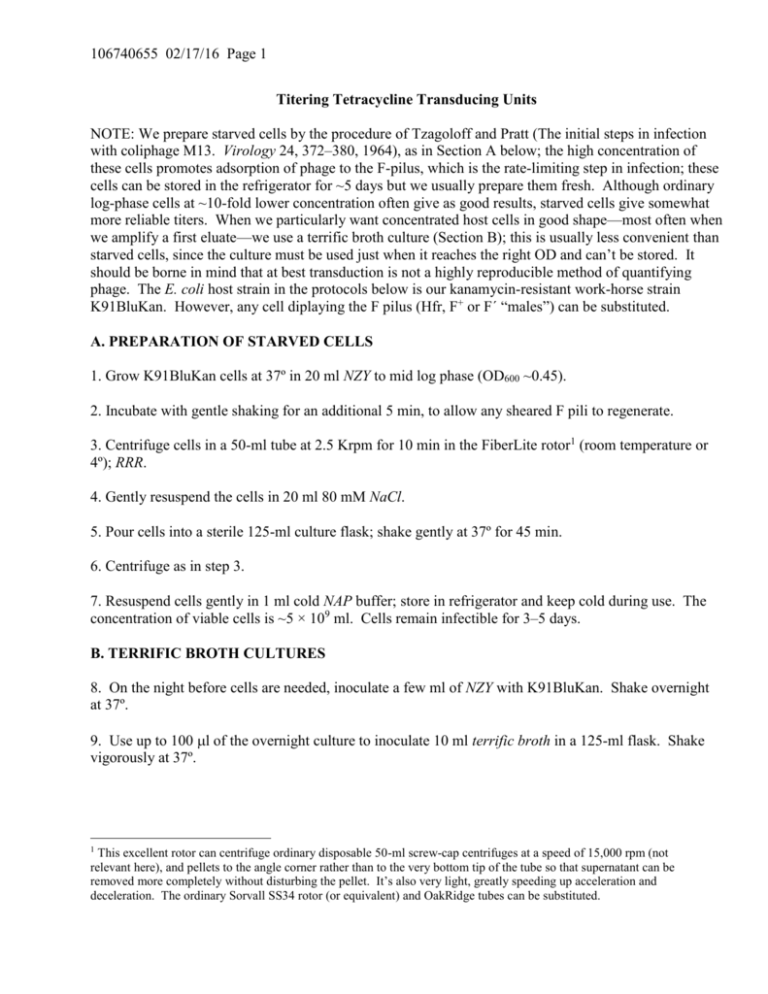
106740655 02/17/16 Page 1 Titering Tetracycline Transducing Units NOTE: We prepare starved cells by the procedure of Tzagoloff and Pratt (The initial steps in infection with coliphage M13. Virology 24, 372–380, 1964), as in Section A below; the high concentration of these cells promotes adsorption of phage to the F-pilus, which is the rate-limiting step in infection; these cells can be stored in the refrigerator for ~5 days but we usually prepare them fresh. Although ordinary log-phase cells at ~10-fold lower concentration often give as good results, starved cells give somewhat more reliable titers. When we particularly want concentrated host cells in good shape—most often when we amplify a first eluate—we use a terrific broth culture (Section B); this is usually less convenient than starved cells, since the culture must be used just when it reaches the right OD and can’t be stored. It should be borne in mind that at best transduction is not a highly reproducible method of quantifying phage. The E. coli host strain in the protocols below is our kanamycin-resistant work-horse strain K91BluKan. However, any cell diplaying the F pilus (Hfr, F+ or F´ “males”) can be substituted. A. PREPARATION OF STARVED CELLS 1. Grow K91BluKan cells at 37º in 20 ml NZY to mid log phase (OD600 ~0.45). 2. Incubate with gentle shaking for an additional 5 min, to allow any sheared F pili to regenerate. 3. Centrifuge cells in a 50-ml tube at 2.5 Krpm for 10 min in the FiberLite rotor1 (room temperature or 4º); RRR. 4. Gently resuspend the cells in 20 ml 80 mM NaCl. 5. Pour cells into a sterile 125-ml culture flask; shake gently at 37º for 45 min. 6. Centrifuge as in step 3. 7. Resuspend cells gently in 1 ml cold NAP buffer; store in refrigerator and keep cold during use. The concentration of viable cells is ~5 × 109 ml. Cells remain infectible for 3–5 days. B. TERRIFIC BROTH CULTURES 8. On the night before cells are needed, inoculate a few ml of NZY with K91BluKan. Shake overnight at 37º. 9. Use up to 100 l of the overnight culture to inoculate 10 ml terrific broth in a 125-ml flask. Shake vigorously at 37º. 1 This excellent rotor can centrifuge ordinary disposable 50-ml screw-cap centrifuges at a speed of 15,000 rpm (not relevant here), and pellets to the angle corner rather than to the very bottom tip of the tube so that supernatant can be removed more completely without disturbing the pellet. It’s also very light, greatly speeding up acceleration and deceleration. The ordinary Sorvall SS34 rotor (or equivalent) and OakRidge tubes can be substituted. 106740655 02/17/16 Page 2 10. When the culture gets quite turbid, start reading the OD600 of 1/10 dilutions. When the OD600 of a 1/10 dilution reaches 0.1-0.2 on Spectronic 20 colorimeter (~0.125-0.25 on a regular spectrophotometer), slow the shaking way down to allow sheared F-pili to regenerate. 11. Use these cells within ~1 hr as you would starved cells. The concentration of viable cells is about the same as starved cells: ~5 × 109 ml. C. ANALYTICAL TITERING 12. Make suitable dilutions of phage, using TBS/gelatin as diluent. Cover a range of dilutions that ensures one with a physical particle concentration of 3 105 to 3 106 virions/ml (~1.5 104 to 1.5 105 TU/ml); the ideal is ~2 × 106 virions/ml (~105 TU/ml). If we are doing lots of infections, we pipette 10 l into wells of a sterile 24-well culture dish (Costar). Otherwise we use sterile 15-ml disposable tubes; these tubes are held at an angle of ~10º from the horizontal, and the 10 l is deposited as a droplet on the inner wall near the top, the angle of the tube preventing the droplet from falling to the bottom. 13. To each phage sample from the previous step add 10 l starved cells (K91BluKan or any other infectible strain; Section A) or terrific broth culture (Section B). If the infection is being done in a 15-ml tube, deposit the cells directly into the droplet of phage to ensure the two are thoroughly mixed. Incubate 10 min at room temperature to allow phage to infect the concentrated cells. 14. Add 1 ml NZY with 0.2 g/ml tetracycline; incubate at 37º for 40 min (on shaker-incubator if convenient). NOTE: As little as 100 l medium can be added at this point if it is necessary to keep the concentration of infected cells higher. NOTE: Theoretically, the low concentration of tetracycline in the medium is sufficient to induce expression of the tetracycline resistance gene without inhibiting protein synthesis. 15. The infected cells are then either spotted (20 l/spot) or spread (200 l/plate) on NZY plates containing 40 g/ml tetracycline and 100 g/ml kanamycin (assuming the host strain is resistant to this antibiotic). For spot titers use dry plates (e.g., 2 days in the 37º incubator, or a few hours open in a laminar flow hood); 19 spots in a hexagonal array fit comfortably onto a 100-mm plate, maximizing the distance between spots. Incubate the plates ~24 hr at 37º.
